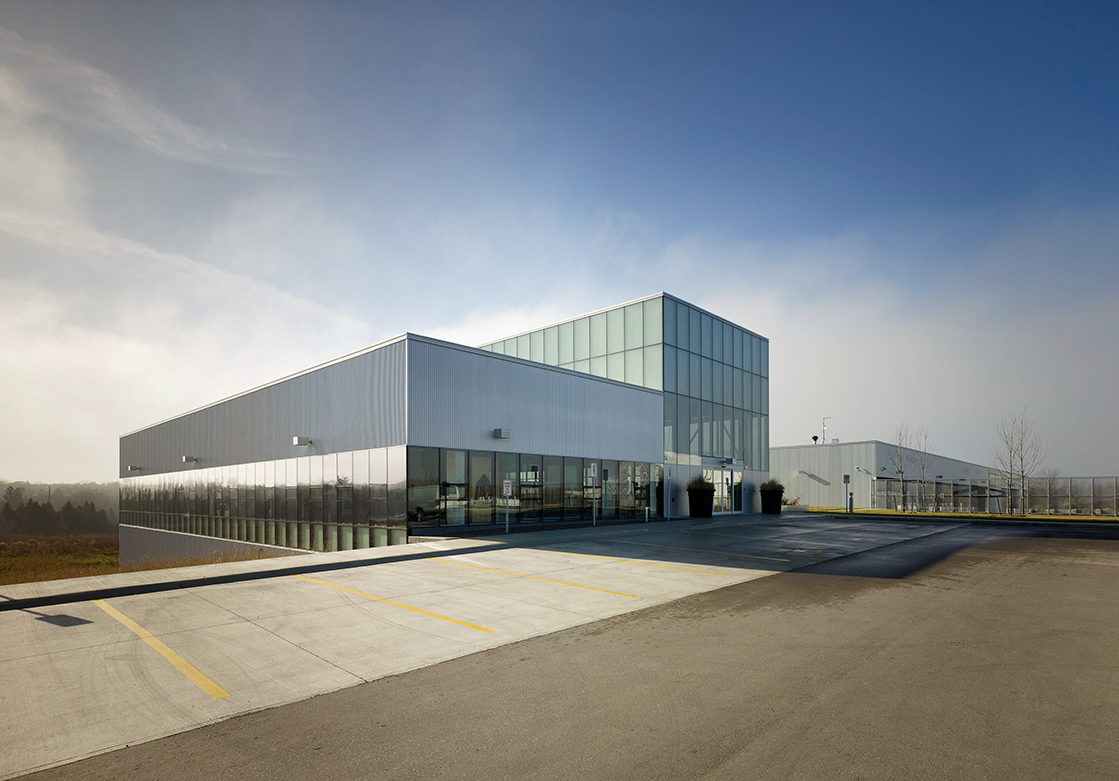Opening the door to an efficient municipal building assembly

The award-winning Municipal Operations Centre in Newmarket, Ont., has achieved both form and function as an esthetically pleasing, energy-efficient facility featuring bi-fold, lift-strap/auto-latch glass doors.
Research and design for the $20.2-million, 6038-m2 (65,000-sf) facility took nearly a year. Project lead architect Geoff Miller of Toronto-based Rounthwaite, Dick & Hadley Architects & Engineers (RDH), says the town was committed to constructing a green building.
“It was our idea to put the decorative, numbered glass doors on the building for two reasons,” Miller explained. “We found the doors when looking for a product that would have numerous functional aspects and be architecturally attractive. This is a prominent building and the town wanted it to be a kind of landmark, featuring the doors facing a major street entering town on a hill and visible for people driving by.”
From a function standpoint, the team was looking for a door system that would not take up ceiling space on the building’s interior, specifically in the repair garages where it is necessary to use a crane. The bi-fold door system seemed ideal as the added advantage was the doors provide an exterior canopy when open, so it somewhat provides an outdoor workspace in the summer.
The glass and aluminum curtain wall on the doors also offer maximum performance. RDH worked closely with the manufacturer to ensure the custom doors met esthetic and energy-efficiency goals. The 20 bi-fold doors measure 5.8 x 6.5 m (19 x 21.3 ft) to accommodate storage, repair, and maintenance areas of trucks, snowplows, and other large equipment. The doors are clad entirely in double-glazed curtain wall and installed flush with the primary building envelope. This allows for transparent and day-lit workspaces in the vehicle bays, while also maintaining thermal continuity.

Ten doors on each side of the facility—all numbered for easy identification by visitors—allow for easy access and drive-through capabilities, as well as provide passive ventilation and reduction of the energy load. During the summer, the doors can be left open during the day to create a seamless indoor/outdoor workspace.
The doors are powder-coated to better protect against the elements and prevent rust. They also include safety features such as warning lights and horns, a door base safety edge, and an emergency backup system.
Municipal operations centres rarely attract attention from architects or the public, but this one has captured plenty of accolades and honours. The Newmarket Municipal Operations Centre received the Governor General’s Medal in Architecture. With contributions from the Federation of Canadian Municipalities (FCM) and Invest in Ontario program, this is one of the first centres of its kind in Canada to be built to Leadership in Energy and Environmental Design (LEED) Silver standards.
A total of 92 per cent of the occupied spaces have daylight and exterior views, which greatly reduces the energy costs and environmental impact, saving an estimated 411 tons of carbon dioxide (CO2) from entering the environment annually.
The design also demonstrated an energy reduction of 44 per cent compared with a similar facility under the model of National Energy Code for Buildings (NECB). It incorporates a 40 per cent reduction in domestic water usage through the installation of efficient fixtures and other water-saving measures, accounting for a savings of almost 1.5 million L (400,000 gal).
Other sustainable features of the building include:
● vegetated roof;
● geothermal heating and cooling;
● solar hot-water-heating;
● reflective membrane roof;
● recharge stations for electric vehicles; and
● stormwater collection to irrigate the roof.
The site is also landscaped with native grasses, plants, and trees to improve biodiversity.
This new facility replaces three separate buildings and meets the needs of the growing Newmarket community. All town vehicles and equipment are now housed in one location, eliminating travel between facilities and maximizing resources.
“We were looking for a type of door that was big enough, that gave us a lot of natural light, and would allow large equipment to get in and out,” said Harry Vanwensem, manager of facility services. “As taxpayers go, they do not always like to see big things come up, but we were able to amalgamate three departments into one operation. It gives us a better team environment to have all the departments under one umbrella.”
 Pat Schmidt is a feature story and technical writer for Schweiss Doors in Fairfax, Minnesota. In the past, he was an award-winning newspaper publisher and magazine editor working for various publications in Minnesota and Alaska. For more information, go to www.schweissdoors.com or call 507-426-8273.
Pat Schmidt is a feature story and technical writer for Schweiss Doors in Fairfax, Minnesota. In the past, he was an award-winning newspaper publisher and magazine editor working for various publications in Minnesota and Alaska. For more information, go to www.schweissdoors.com or call 507-426-8273.







